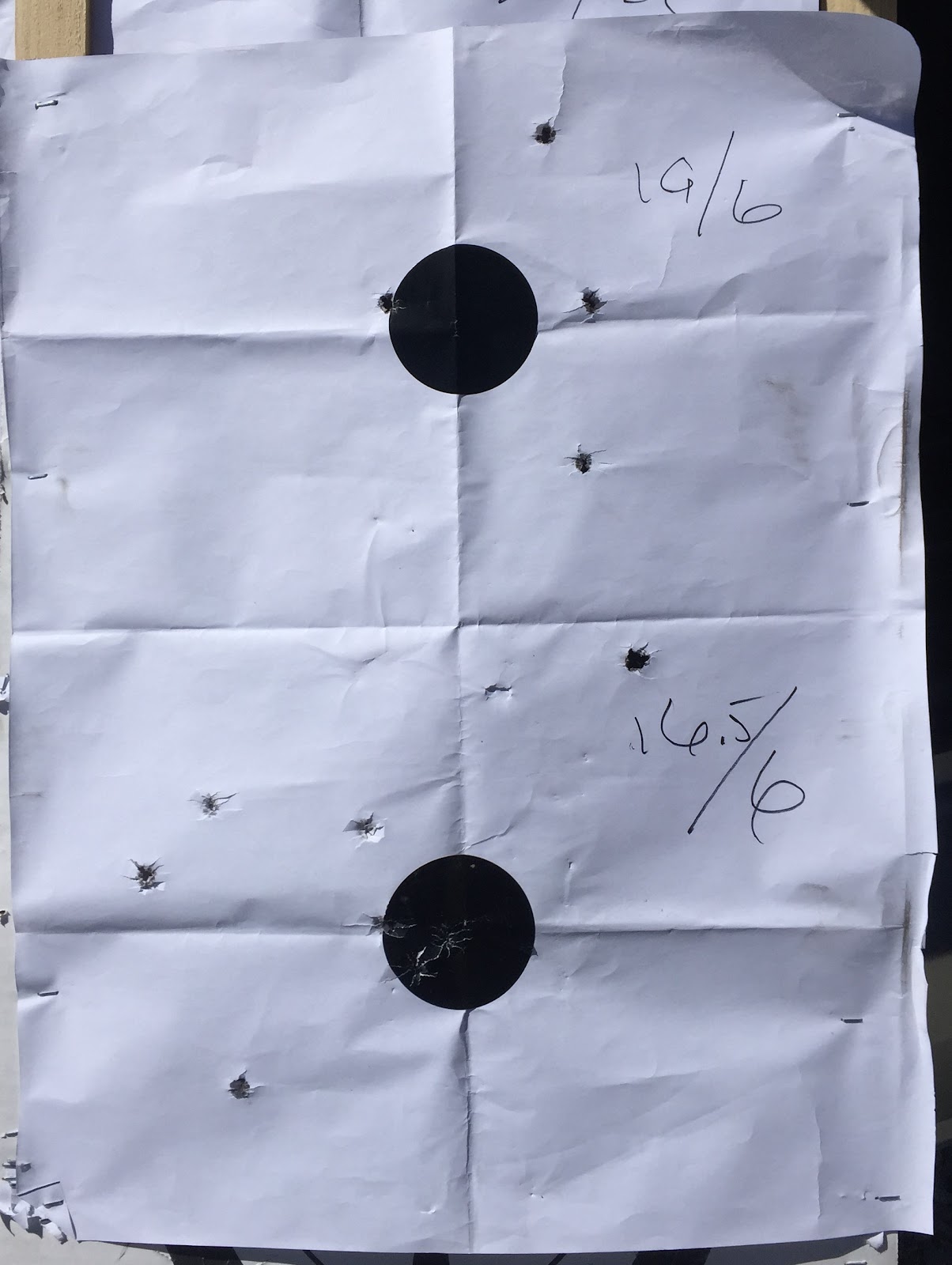Typically, this is where most of us will cite a long list of reasons they didn't shoot well, and I'm not going to do that--I just had a bad day, and that's on me. However, having admitted that, there are two factors I should mention in the interest of scientific accuracy. First, the wind was very heavy from 8:00; I doubt that affect the pistol bullets much, but I strongly suspect it did affect the carbine bullets, especially when I tried to aim off to allow for it. I really think aiming off is the big problem I'm having with most of my rifles--not just the Smith. My eyesight is bad enough that the hair thin front sight on the Smith is very hard to see, and targets at 50 yards are more even more so. So when I am aiming off (if you're new to this blog, "aiming off" is the practice of setting your sights on some part of the target other than the bullseye to allow for wind, or drop due to distance, or even offset sights, etc.), it's hard to pick a consistent spot at which to aim, which tends to make the groups open up a bit; I think I need to put an actual mark to aim at on the targets for elevation. I think if I get a thicker front sight post (to make it easier to see) and one that is taller (so I don't have to aim 12 inches below my intended mean point of impact), I will be able to get *much* better string tests. The short version of today's results is that if you add all the scores together, my result was a disappointing 5.2 inches/round with the Smith carbine today; compare that with my average score of 2.94 in./rd. in November.
Second, I was unable to set up my pistol targets at 15 yards as I usually do, and had to shoot at 25 yards instead, so naturally the groups opened up a bit from my usual results. If you add the strings for all four tables of pistol fire, you end up with an average of 3.2 inches/round, which, given the 2.5-3.0 inches/round I've been averaging at fifteen yards isn't really that bad (unless you compare it to my all-time best of 1.7 in./rd.!).
By the way, if you're not yet familiar with the String Test method for gauging accuracy, you are really doing yourself a disservice. The String Test is a way of calculating the average distance of each round from the bullseye. It is vastly superior to simply calculating the group size since group size doesn't take into account how close the group is to what you're trying to hit, whereas the string test takes both ideas--the tightness of the group and how close that group is to what you're trying to hit-- and condenses them into a single number that can be precisely tracked and used to gauge how well you're doing, or how a specific load changes things, etc. To learn more about the String Test, read this.
The weather was dry and sunny, 44 deg., wind heavy from 8:00. All shooting was offhand, 50 yards for the Smith and 25 yards for the Remington New Model Army.
The Smith carbine cartridges were loaded with greased Smith bullets cast in a mold from Eras Gone Bullet Molds and 35 grains of Schuetzen 3F powder. To learn how they were made, read this.
The revolver cartridges were combustible paper cartridges made with Kerr bullets from an Eras Gone mold with 25 grains of either Pyrodex "P" or Schuetzen 3F (and yes, I forgot to write down which batches where which for comparison, and I am kicking myself about that lost opportunity for comparison!). To learn how they were made, read this.The targets in the pictures below are 18"x24", and the black dots are 3" in diameter, just for comparison. |
| Table One--Smith |
String Test: 10 rounds, 38 inches = 3.8 in./rd.
 |
| Tables Two and Three--Remington |
String Test: 5 rounds, 15 inches = 3.0 in./rd.
Table Three: Remington New Model Army
String Test: 5 rounds, 20 inches = 4.0 in./rd.
 |
| Table Four--Smith |
String Test: 10 rounds, 42 inches = 4.2 in./rd.
 |
| Tables Five and Six--Remington |
Table Five: Remington New Model Army
String Test: 6 rounds, 19 inches = 3.2 in./rd.
Table Six: Remington New Model Army
String Test: 6 rounds, 16.5 inches = 2.7 in./rd.
 |
| Table Seven--Smith |
String Test: 13 rounds, 90.5 inches = 6.9 in. rd.
(NB: I wasn't cleaning my barrel, and it is possible the fouling by this point was causing my results to get worse.)








Interesting article. My wife and I have shoot original Smith carbine since 1983. My load is 28grain 3f, milk carton spacer with 7 grain of grits on top. The bullet is maynard bullet (Romano rifle company). The key is the distance of the chamber to the rifling. The smaller the bullet jump to the rifling the better. Both carbine will shoot 1.5 to 2" at 50yards. The lube I use is SPG lube. this lube doesn't melt when the outside temp are in the 80's
ReplyDeleteIf you follow the link in the entry above you can read how I load the cartridges.
Delete